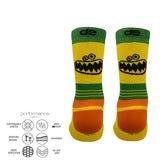Trail socks and technical specifications.
The complete guide to stability, comfort, and durability
In the mountains, every detail matters.
From tying the laces to the fabric of the sock, everything plays a role in stability, comfort, and – ultimately – your performance. Technical socks are not just an accessory; they are the link between the foot and the shoe, the point where technology meets the feel of the ground.
In this guide, we will revisit what you need to pay attention to, which technologies really work on the trail, and how to choose the pair that will support you on every run.
🏔️ Why trail socks are not like regular running socks
Anyone who has run even once on a trail knows that the terrain changes constantly: stones, roots, mud, water.
This means you need more controlled grip inside the shoe , better shock absorption and higher shock management .
Trail socks are designed precisely for this:
-
to stabilize the footbed,
-
to reduce wear and fatigue,
-
to keep the foot dry and comfortable, even after hours.
⚙️ Technologies that make a difference
Technology in socks has advanced much further than you might think. Here are some points worth noting:
Grip zones
Grip zones that prevent the foot from slipping inside the shoe — particularly useful on descents or other braking.
Cushion System at heel & toes
Targeted cushions that absorb shocks and reduce fatigue on long runs.
Arch Compression & anatomical fit
Stabilize the arch, keep the footbed aligned, and limit micro-movements that cause irritation.
Breathable Mesh & moisture management
Special breathable knit that wicks away sweat and helps keep feet dry and cool – key to avoiding blisters.
Reinforced wear points
High-density knit at the heel and toes, for durability and longevity, even on the most demanding runs.
🧦 The height that makes the difference
The height of the sock is not just a matter of style.
-
Below the calf (Crew): covers the ankle and part of the calf, protecting against scratches, stones, and contact with the shoe.
-
Quarter (mid-cut): a lighter option for warm weather or quick, clean terrains — less coverage, more freedom.
🧵 Materials & feel on the foot
The right material makes the difference between a comfortable ride and one full of blisters.
High-performance socks usually combine polyamide fibers for durability and a secure fit with breathable knits that keep the foot cool.
Additionally, the hypoallergenic dyes certified by OEKO-TEX® ensure safety for the skin.
The result? Soft step without 'sinking' and stable grip without pressure.
"🛣️ Road vs Trail – When do I choose what?"
-
"The" "road socks." "They are designed for stable surfaces, with lighter cushioning and less reinforcement."
-
The trail socks, on the other hand, prioritize stability, protection, and management of external conditions.
If you run both, the All-Terrain solutions combine the best features of both worlds.
"📏 Fit & size."
"The perfect sock should 'hug' your foot without wrinkles or loose spots."
Choose the right size for your shoe and prefer socks with flat seams at the toes — they prevent irritation and offer greater comfort on descents.
"🧼 Care that extends the lifespan."
"Proper maintenance keeps the sock's performance for much longer."
Wash them in cold or lukewarm water, on a gentle cycle, and avoid the dryer.
Turn them inside out before washing for better sweat and salt removal, and do not use fabric softeners — they reduce the breathability of the fibers.
🏃 desocks options for Trail
-
Trail Crew / All-Terrain Crew: crew height for protection, Hybrid Grip for stable footing, and Cushion for comfortable descents.
-
Half-length : for training focused on breathability and freedom of movement.
👉 Check the collection: [Trail Crew] and [All-Terrain Crew]
(add your internal product links here)
💬 Frequently Asked Questions
Do I need different socks for summer and winter?
Yes. In summer, prefer thinner, breathable socks. In winter, a bit more cushion and crew height for warmth and protection.
How do I avoid blisters on the trail?
Choose the right size, breathable mesh fabric, flat seams, and padding at pressure points.
What height should I choose?
For trails with grass or stones → Crew .
For clean, fast terrain and warmth → Quarter / Low .
🌄 Ready for the next trail?
Discover the desocks Trail options and find the application that fits your step.
→ [Δες τη συλλογή Trail]






